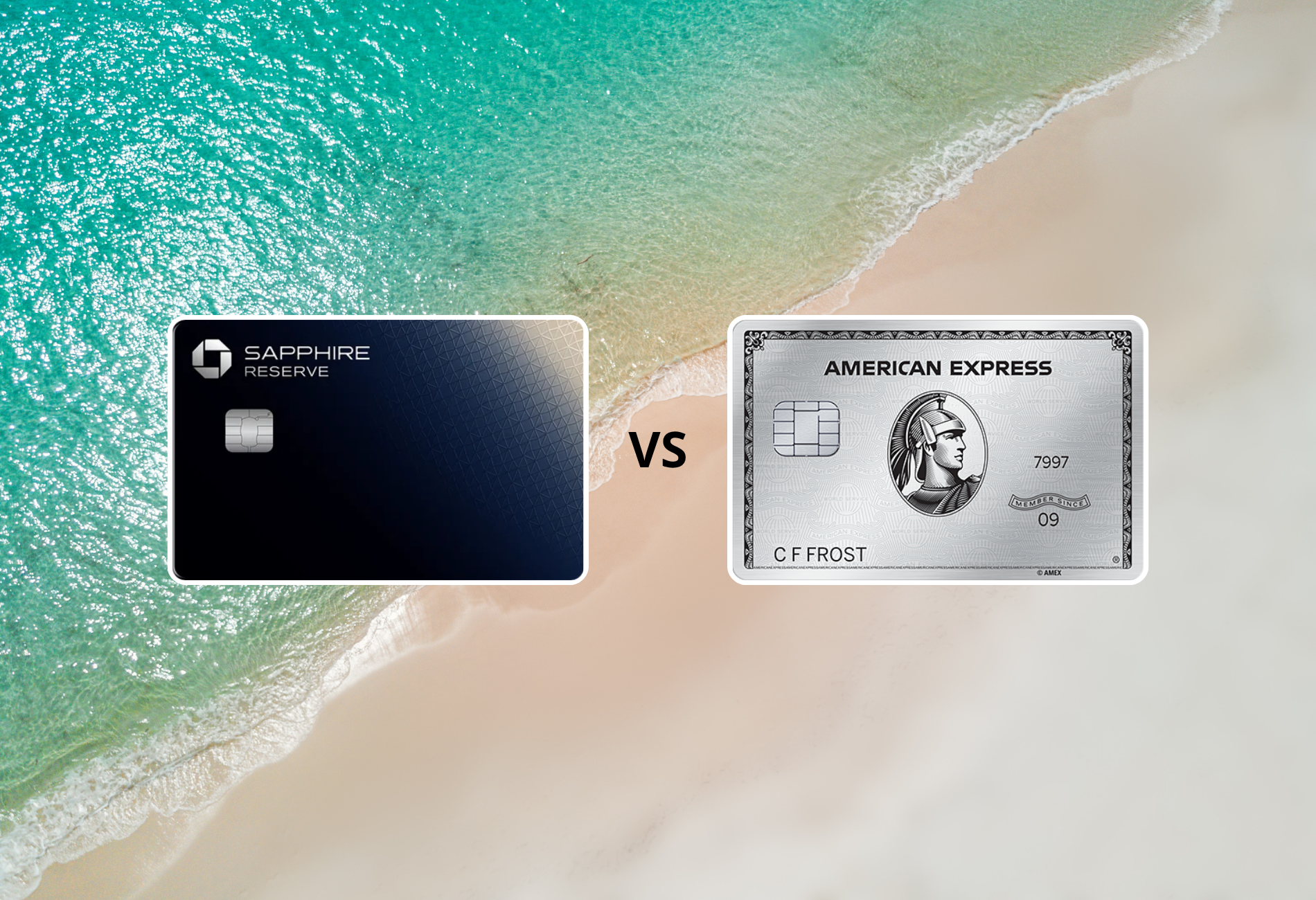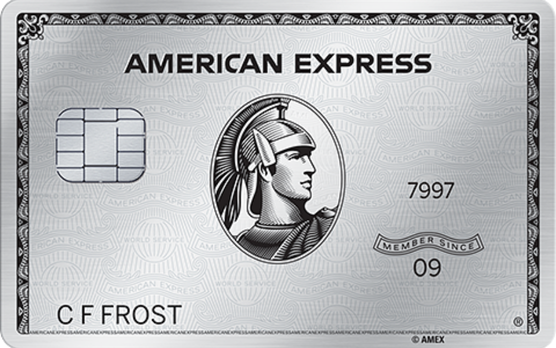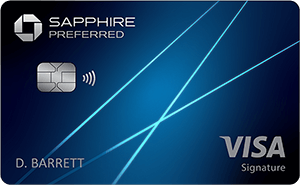Overview
This wallet ain’t big enough for the two of ‘em.
Well, technically, there’s plenty of space, but with the Chase Sapphire Reserve®’s new astronomical fee pushing premium cards into an entirely new spectrum, having more than one of these big-hitting products doesn’t make too much financial sense.
For years, American Express Platinum Card® was the pinnacle of luxury credit cards. Its annual fee dwarfed its competitors, but validated it with enhanced lounge access and untouchable perks. But the Reserve’s high-end rebrand is a statement, a thrown gauntlet, and we can expect Amex to respond with its own changes within the next few months.
But as for right now, how do the two Goliaths of premium cards stack up to each other? Is the Reserve’s new look and big bonus enough to pry you away from the Amex’s nostalgic glamor and outstanding lounge access? Or is it worth diving on the Platinum now, before the inevitable fee increase later this year? There’s only one way to find out: A premium card showdown between the Amex Platinum and the Chase Sapphire Reserve.
Seven rounds. One winner.
Let’s get ready to rumble.
- Best for: Luxury Perks
American Express Platinum Card®
As high as 175,000 Membership Rewards® Points
Offer Details:
You may be eligible for as high as 175,000 Membership Rewards® points after you spend $8,000 in eligible purchases on your new Card in your first 6 months of Card Membership. Welcome offers vary and you may not be eligible for an offer. Apply to know if you’re approved and find out your exact welcome offer amount – all with no credit score impact. If you’re approved and choose to accept the Card, your score may be impacted.
Why we like it
The Amex Platinum was once the sole dominating force in the luxury credit card space. While it now faces some stiff competition, it still offers unbeatable perks like unprecedented airport lounge access, elite status at Hilton and Marriott, and some outstanding statement credits making the mammoth $895 worth it for some.
Reward details
Get more for your travels with 5X Membership Rewards® points on all flights and prepaid hotel bookings through American Express Travel®, including Fine Hotels + Resorts® and The Hotel Collection bookings.
You earn 5X points on flights purchased directly from airlines or through American Express Travel® on up to $500,000 on these purchases per calendar year.
Pros & Cons
Pros
-
Earn as high as 175,000 Membership Rewards® Points after you spend $8,000 on eligible purchases on your new Card in your first 6 months of Card Membership.
-
Incredible lounge access
-
Statement credits worth over $3,500 annually.
-
Unlock access to exclusive reservations and special dining experiences with Global Dining Access by Resy when you add your Platinum Card® to your Resy profile.
Cons
-
The $895 annual fee is brutally high. Too high for many that can’t, or don’t want to take full advantage of its benefits.
-
Points-earning rates are low unless spending directly on flights or with the Amex Portal.
-
Some of the benefits, like travel credits, are more limited and are harder to use than competing cards’ offerings.
Round 1 - Annual Fees and Authorized User Costs
Honestly, in this round, it’s like those terrible Alien versus Predator movies. Whoever wins, we lose. Both cards have immense annual fees. The Platinum’s $895 fee (see Rates and Fees) dropped jaws around the points world when it arrived in 2021. The Reserve’s new $795 annual fee has pushed things even further, ushering in a new era of “ultra-premium” credit cards. Each card charges $195 for authorized users.
Both of these are extremely expensive, and I’m compelled to remind you that if you can’t get value from these cards, those fees will hurt you in the long run. Do the math before making any decisions. For now, we’re going to have to give it to the Reserve, simply because it’s cheaper.
Winner: Chase Sapphire Reserve
Round 2 - Introductory Offers
If high annual fees are the credit card equivalent of heavyweight fighting classes, then introductory offers are the signature moves. But do they both land haymakers? Well, it depends.
On paper, Amex steals this round with an introductory bonus as high as 175,000 Membership Reward Points after spending $8,000 within six months of opening the card. It sounds great, but the operative words there are “as high as”. You’re not guaranteed 175,000 points. Welcome offers vary and you may not be eligible for an offer. There doesn’t appear to be any set verbiage in the terms and conditions, but general recon suggests you’ll be offered 100,000, 125,000, or 150,000 points if you don’t qualify for the full amount. The spending requirement will stay the same regardless of which you’re approved for.
The good news is that you don’t have to commit to the card until you’ve seen the offer. Amex runs a soft credit check during the application process, so it won’t impact your score until you’ve officially accepted it. Again, this could change in a few months, but it’s the current situation.
The Sapphire Reserve, on the other hand, is running one of the best intro bonuses we’ve ever seen. It’s offering an exceptional 125,000 Ultimate Rewards Points after spending $6,000 within three months of opening the card. While it’s not as high as 175,000, it’s consistent, it’s high-value, and it requires less spending (albeit within a shorter timeframe).
To keep with the boxing allegory, when Amex’s bonus offers make contact, they’re a knockout. 175,000 points is huge. But there’s no guarantee of it. The Reserve’s strong, consistent, and generous offer beats Amex out in this round.
Winner: Chase Sapphire Reserve®
Round 3 - Earning Rates
Earning rates are where cards cement their wallet staying power. Are they one-hit wonders that lose value after the intro bonus is gone, or can they keep gifting the holder for months and years of spending?
The Sapphire Reserve definitely looks the part, offering a number of travel-centric bonus earning categories.
8 points per dollar on all Chase TravelSM purchases.
4 points per dollar on flights and hotels booked directly with the airline or hotel.
3 points per dollar on dining worldwide
5 points per dollar on eligible Lyft rides (Through Sept 30th, 2027) and 10 points per dollar on eligible Peloton rides (Through Dec 20th, 2027)
1 point per dollar on all other spending
The Amex Platinum keeps things more bare bones and far more internal.
5x points per dollar on flights booked with airlines or through American Express Travel on up to $500,000 a year, then 1x.
5x points per dollar on prepaid hotels on Amextravel.com
1x points per dollar on all other spending
It’s closer than it looks, but the Reserve pips the Platinum to the post in this round thanks to its superior flexibility. If it had retained its old spending categories, it wouldn’t even have been close. It’s the dining bonus that elevates things.
It will be interesting to see if Amex opts to change its earning strategy when the looming rebrand happens.
Winner: Chase Sapphire Reserve®
- Best for: Luxury Travel
Chase Sapphire Reserve®
125,000 bonus points
Offer Details:
Earn 125,000 bonus points after you spend $6,000 on purchases in the first 3 months from account opening.
Why we like it
This card just got a major re-vamp and you can now get more than $2,700 in annual value with Sapphire Reserve!
Reward details
8x points on Chase TravelSM
4x points on flights and hotels booked direct
3x points on dining
1x points on all other purchases
Pros & Cons
Pros
-
The points are worth up to 2 cents a piece when used directly on Chase’s Ultimate Rewards Portal, offering a simple but high-value use for your points.
-
Plenty of excellent transfer partners allow points to be maximized
-
Some excellent partnerships with Doordash and Lyft add to its value.
-
Priority Pass membership allows access to over 1,300+ airport lounges and restaurants.
Cons
-
It’s subject to Chase’s 5/24 rule. So if you’ve opened five cards in the last two years, you’re most likely not going to be accepted.
-
Chase has a once-per-lifetime rule for sign-up bonuses on their Sapphire cards, including the Sapphire Preferred, Sapphire Reserve, and Sapphire Reserve for Business. So, once you’ve earned a welcome bonus on any of these cards, you’ll never be eligible for the bonus again on the same card.
Terms Apply
Round 4 - Points Power
Of course, earning points means nothing if the points aren’t worth anything.
Thankfully, both Chase and Amex boast some of the most valuable points on the market. Honestly, this is a neck-and-neck round, where personal preference can play a huge factor. We’d strongly advise having a card from each issuer to maximize your coverage and ensure you give yourself the best chance at a high redemption.
We value Chase Ultimate Rewards slightly higher than Amex, thanks to its more unique transfer partners like Hyatt, and the ability to spend points on Chase TravelSM at higher rates, too. While the system has recently changed from a flat 1.5 cents on Chase TravelSM to a dynamic system, it does mean you can get as much as 2 cents per point on the platform. Amex, meanwhile, keeps redemptions on its own platform to a sultry 1 cent per point.
That’s not to say it’s useless. Far from it. We still value Amex points at 2 cents each on average, thanks to its excellent array of transfer partners. A 100,000-point Amex bonus could easily stretch beyond $2,300 in value.
Winner: Chase Sapphire Reserve® (for flexibility)
Round 5 - Statement Credits
This is a vital round for any premium card. With annual fees as high as they are, issuers need to provide enough opportunity for consumers to recoup that value. Sadly, it’s becoming more normal for cards to operate like coupon booklets, forcing customers into spending where they wouldn’t necessarily do so, just to feel like they’re getting their money’s worth.
Both the Reserve and the Platinum follow this playbook to a certain extent, but how much real value can either of them provide?
Here’s the full lineup of the Platinum’s current annual statement credits and perks:
-
Up to $200 Airline Fee Credit
-
More Value! Up to $600 Hotel Credit
-
New! Up to $400 Resy Credit + Platinum Nights by Resy
-
Up to $200 Uber Cash + up to $120 Uber One Credit
-
More Value! Up to $300 Digital Entertainment Credit
-
Up to $155 Walmart+ Credit
-
Up to $100 Saks Credit
-
Up to $300 in Equinox credit
-
Up to $300 in annual SoulCycle at-home bike credit (for up to 15 bikes)
-
Up to $300 lululemon Credit
And here’s the Reserve’s annual counter-punches:
-
Up to $300 annual travel credit
-
Up to $500 annual credit for stays with The Edit (plus $100 property credits)
-
Up to $120 TSA PreCheck or Global Entry credit
-
Up to $300 annual Sapphire Reserve Exclusive Tables dining credit
Up to $120 annual Dashpass membership
Up to $300 annual in DoorDash credits
Up to $300 annual in StubHub credits
Up to $250 annual Apple TV+ credit
Up to $120 annual Lyft Credit
Up to $120 annual Peloton credit
After spending $75,000 in a single year, you’ll also get:
-
$250 credit for The Shops at Chase
-
$500 travel credit for Southwest Airlines
Again, both of these read like coupon books, and their value will be dictated almost exclusively by the individual cardholder. The best and easiest credit to use is, by far, the Reserve’s $300 travel credit. It can be used on anything travel-related, not just from Chase TravelSM. It has a low barrier to entry, which makes it incredibly valuable. Amex’s airline and hotel credit are both helpful, too, as long as you travel enough, but almost any other credit listed will be dictated by your individual lifestyle.
Winner: TIE (The Reserve gets a moral victory for its $300 travel credit)
Round 6 - Lounge Access
Let’s be honest. Most of us, myself included, opened our first premium credit card for two reasons: a big bonus and lounge access. We all want that feeling of strolling into a high-end lounge, carry-on bag fluttering weightlessly behind, and plonking ourselves down with a glass of bubbly and some free grub. It’s travel as it was meant to be.
And while there are some serious crowding and quality issues on the lounge front these days, it’s still the best individual perk a credit card can give you.
Both of our competitors offer unlimited Priority Pass Memberships, which grant the holder and a guest access to over 1,300 lounges around the world. It’s a brilliant system, and it would cost about $469 out of pocket without a credit card — something to remember if neither of these cards makes sense for you. So they’re neck and neck at this point.
But it’s here that the similarities end, with the Platinum demolishing the Reserve’s extra lounge offerings. Platinum cardholders have access to Amex’s excellent range of Centurion lounges around the world, as well as limited access to Delta Sky Clubs and some Virgin Clubhouses. Chase is building its own lounge range (and allows two guests to the Platinum’s only-paid guests Centurion entry), but it’s still years away from competing with Amex on a numbers basis. It does offer access to Priority Pass Alternatives, though, which is a nice add-on in some airports.
Winner: The Platinum Card® from American Express
Round 7 - Perks, Benefits, and Add-Ons
While most of the cards’ notables have already been highlighted, there are a few more that can fly under the radar. Some add experiential value, some offer savings, and some manage both. But one card goes above and beyond the other.
The Platinum is generous with its elite status offerings. Just owning the card entitles you to Hilton Honors Gold Status, Marriott Bonvoy Gold Elite Status, and elite status with Hertz Gold Plus Rewards, Avis Preferred, and National Car Rental Emerald Club Executive. Will they help everyone? No. But they’re a tremendous add-on to those who can and will use them. Throw in the underrated Amex Conierge, which can help you do anything from book hard-to-get tables to planning a trip, the Cruise privileges program, or the little-known International Airline program, and you’ve got an array of add-ons that can complement any traveler’s toolkit.
The Reserve Card does offer Platinum Elite Status with IHG rewards and 3-month Gold status with Marriott that can be extended by staying three nights, but nothing on the same level as Amex. Its other big perks are reserved for big spenders who hit the $75,000 mark in a year. It does have a similar service to Amex’s Concierge, which is called Reserve Travel Designers, but it’s not as involved as the former’s offering.
Winner: The Platinum Card® from American Express
The Result - It’s a Bloody Tie (but not really)
Of course it is. But this makes sense. Both cards are premium products, but they’re going after different markets. Just reading this article should have sparked an interest in one or the other for you. Broadly peaking, if you’re set on luxury experiences and high-end perks, the Amex Platinum steals the show. But if you want a slightly more practical earner with actionable perks, the Reserve could be the right card for you.
But, as I mentioned earlier, Amex is expected to launch a major rebrand of the Platinum card in the Fall. We can expect a higher fee, new or improved perks, and hopefully not too many more coupon-book-based statement credits. We’ll have to return to this fight later in the year to see where things stand.











 by your friends at The Daily Navigator
by your friends at The Daily Navigator



